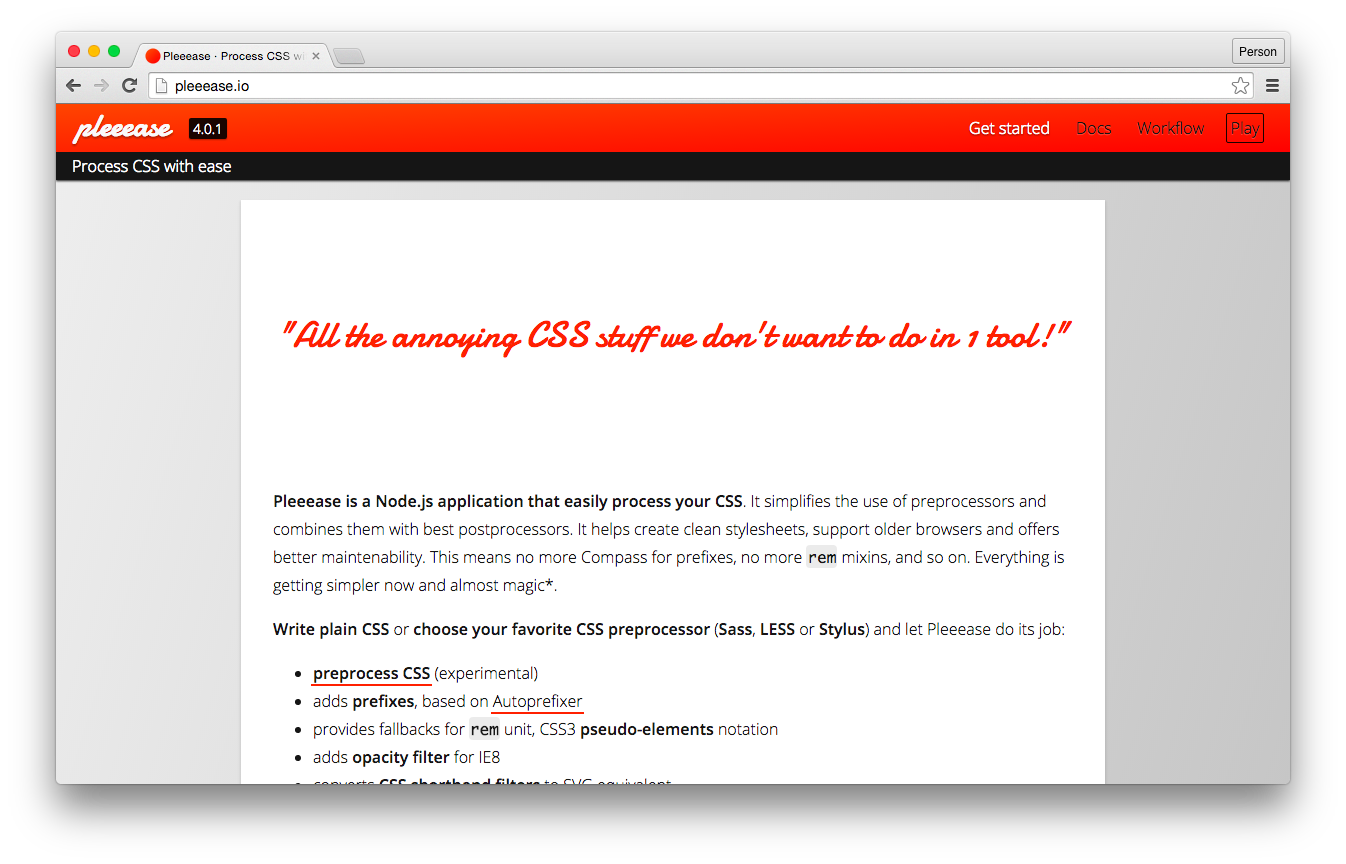Simplicity in Front-End Tooling
We tend to solve a lot of problems related to the front-end by delegating them to existing programs. We use libraries and tools which we don’t understand completely - our code base grows and grows. But lately this trend seems to change and we slowly re-consider what we can do best: develop front-end code. What can we expect from this new trend and how can we use them in out daily business today?

Disclaimer: This article was first published in Screen Guide Magazine in No. 26 in German as the Working Draft Kolumne.
A few years ago designers developed a trend for more streamlined minimalistic websites. WordPress templates were not polluted by bubblegum artworks but became more functional. Blogs begun to focus on the content instead of design. “Do one thing, do it right” became a credo.
Tooling to the Rescue
Contrary to this developers used more and more tools to create websites, complexity of front-end code grew and we expected developers to know about all the tools that popped up. The positive site of this: Our work became more professional. We started as webdesigners and are now known as Front-end Engineers or Architects, developers with deep knowledge of programatic paradigms and optimization workflows which you need to generate modern, good performing and – at least – minimalistic websites.
Pre-processors and Build Workflows
When I first used Sass a couple of years ago it was a blessing for me: Finally I could use variables and nesting, no vendor prefixes anymore. My code became easier to understand because I could use mixins and functions and avoid redundancy. I played around with other pre-processors like Stylus and LESS to discover that Sass was the most easiest to understand for me and other developers that know CSS already.
The old Ant-based HTML5 Boilerplate builder was replaced by a modern Grunt workflow which I finally understood at some point and was able to fix by myself whenever I needed to. Thousands of Grunt plug-ins are now available on npm and as a developer I only need to understand the configuration and how the different plug-ins work together. But if you want to stack some tools together for example RequireJS with it’s builder r.js for JavaScript modules and Jasmine utilized by Karma for unit testing. It turns out it is not that easy to implement all these tools to play nicely together.
New Direction: Simplification
Within the last months the game seems to change. Developers want to leave behind
all the complexity that they have build up over time. For example in CSS
we disdain formerly loved functionality because of the experience we gathered.
Hugo Giraudel
writes about the pitfalls of Sass’ @extend.
Twitter and other companies do not use pre-processors for CSS anymore and move
back to use Vanilla CSS to style their web apps. This is because CSS can do
more than it used to and it will get more functionality in the near future. In
the end this is the success of developers and users of pre-processors which
engage in the discussion about the specification.

But how can we include these new features in today’s code?
In general: We add another tool to our workflow to reduce complexity. For
example Pleeease used to add compatibility for CSS
features which will be supported in browsers in the future: variables (aka.
Custom Properties) and the color function. This
changed lately and you
can use cssnext to get these features.
Pleeease still helps you with vendor specific prefixes via Autoprefixer, old IE
filter support, rem fallback and more.
In JavaScript we use ES6 transpilers like Babel to add new language features like object orientation, block level variables and modules. These tools transpile “new” code to code which can be understood by today’s browsers.
For app developers there is another player in this game: CSS Modules - compiling your CSS through JS. This approach clearly helps you in writing less complex styles since the scoping of these styles become very clear. On the other hand you move more complexity to your JavaScript and don’t respect the approach of separation of concern.
Pre-Processor vs. Post-Processor
What a contradiction. We trade pre-processors for post-processor and thus
replace one tool by another. This doesn’t seem to be the way we want to go. BEM
becomes the de facto standard in CSS class naming but on the other hand most
developers don’t understand their own class names from a couple of years ago.
JavaScript libraries which provide helpers such as map, forEach or reduce
get banned from our code because browsers can do it on their own by now. But we
include new, more complex libries to build stuff faster as before. Who really
knows the difference between React.js Components and Angular Directives on first
sight?! And then again Polyfills fill the gap which new technology bring to our
browsers.
Apart from that we can utilize front-end frameworks such as Bootstrap and Foundation that provide a great starting point for certain projects. Finding an entrance to those toolkits is made easy for most developers. If you try to understand what is really going on these component libraries become complex monsters and hard to handle.
With Grunt and Gulp as build tools it’s the same: We only replace existing tools like Ant and Make - same as we did with HTML5 Boilerplate’s build tool.
I get the feeling we just transfer complexity somewhere else.
This is what my Working Draft co-host Stefan Baumgartner says to the new trend to use npm as a build tool.
If you still want to use npm as a build tool I cover this in another article.
The Real Problem
For me all of this is not a real problem. Why should we pass on a tool which makes our lives easier? We use a dedicated editor and not Text Edit to write our code even though Text Edit is easily accessible by Mac users and you can write the same code on both editors.
From my perspective for example Pleeease is the right approach to bring developers back to the basics of CSS development and to promote writing simple and thus easy-to-understand code. Furthermore ES6-to-ES5 transpilers bring new features which are direct improvements for us as developers. But still each case asks us to review the purpose of the technology we use.
In one of my projects we discussed how much time it was worth to ramp up a developer who joins the team. If we differ from a certain default it takes time to build up knowledge and to share it - whether it’s in a one-on-one conversation or in documentation which has to be written. But the problem is that there is no such thing as a default when it comes to tools and code conventions. It all depends on people who work with the code and can be very individual - especially for long term projects.
To me it’s not about removing tools from your workflow. I believe it is necessary to find the right tool for each individual case and with this keeping complexity to a minimum. This reduction should be most important. For me personally this means that I no longer use INIT as a starting point for each and every project even though the basic functionality seems to be the same. Complexity should be as little as possible - this is most important.
Conclusion
My decision to use Sass because it is easy to understand for someone who is used to CSS was wrong. Nothing is easier to understand for someone that is used to CSS than CSS itself. Lately in new projects I do not use Sass anymore. Websites and apps we build become more complex year over year and we write code for applications which should replace native software. Even here you can find this anti-trend of removing complex structure and tools in favor of doing “just” our work.
I mostly quit following each tool that pops up week after week. But from time to time I test new tools and think about how they can help me with my projects - just so I do not miss the trend. Especially if this trend is towards a more simplistic environment.